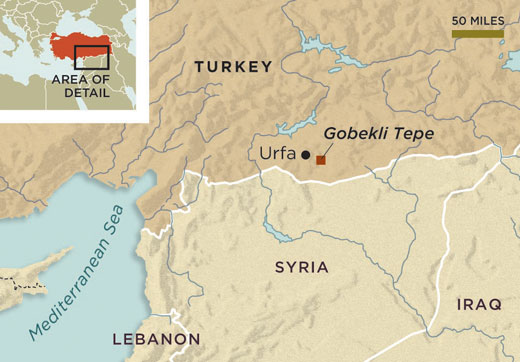At first glance, the fox on the surface of the limestone pillar appears to be a trick of the bright sunlight. But as I move closer to the large, T-shaped megalith, I find it is carved with an improbable menagerie. A bull and a crane join the fox in an animal parade etched across the surface of the pillar, one of dozens erected by early Neolithic people at Göbekli Tepe in southeastern Turkey. The press here is fond of calling the site “the Turkish Stonehenge,” but the comparison hardly does justice to this 25-acre arrangement of at least seven stone circles. The first structures at Göbekli Tepe were built as early as 10,000 B.C., predating their famous British counterpart by about 7,000 years.
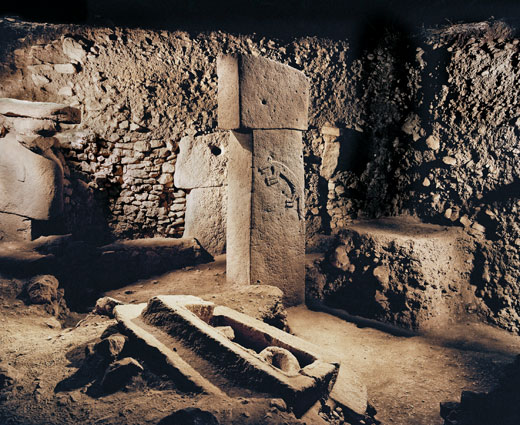 The oldest man-made place of worship yet discovered, Göbekli Tepe is “one of the most important monuments in the world,” says Hassan Karabulut, associate curator of the nearby Urfa Museum. He and archaeologist Zerrin Ekdogan of the Turkish Ministry of Culture guide me around the site. Their enthusiasm for the ancient temple is palpable.
The oldest man-made place of worship yet discovered, Göbekli Tepe is “one of the most important monuments in the world,” says Hassan Karabulut, associate curator of the nearby Urfa Museum. He and archaeologist Zerrin Ekdogan of the Turkish Ministry of Culture guide me around the site. Their enthusiasm for the ancient temple is palpable.
By the time of my visit in late summer, the excavation team lead by Klaus Schmidt of the German Archaeological Institute has wrapped up work for the season. But there is still plenty to see, including three excavated circles now protected by a large metal shelter. The megaliths, which may have once supported roofs, are about nine feet tall.
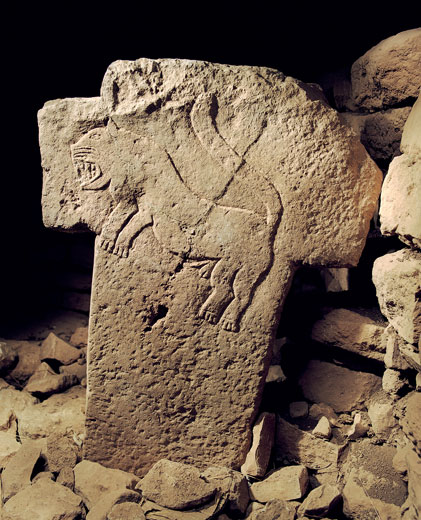 Göbekli Tepe’s circles range from 30 to 100 feet in diameter and are surrounded by rectangular stone walls about six feet high. Many of the pillars are carved with elaborate animal figure reliefs. In addition to bulls, foxes, and cranes, representations of lions, ducks, scorpions, ants, spiders, and snakes appear on the pillars. Freestanding sculptures depicting the animals have also been found within the circles. During the most recent excavation season, archaeologists uncovered a statue of a human and sculptures of a vulture’s head and a boar.
Göbekli Tepe’s circles range from 30 to 100 feet in diameter and are surrounded by rectangular stone walls about six feet high. Many of the pillars are carved with elaborate animal figure reliefs. In addition to bulls, foxes, and cranes, representations of lions, ducks, scorpions, ants, spiders, and snakes appear on the pillars. Freestanding sculptures depicting the animals have also been found within the circles. During the most recent excavation season, archaeologists uncovered a statue of a human and sculptures of a vulture’s head and a boar.
As we walk around the recently excavated pillars, the site seems at once familiar and exotic. I have seen stone circles before, but none like these.
Excavations have revealed that Göbekli Tepe was constructed in two stages. The oldest structures belong to what archaeologists call the early Pre-Pottery Neolithic A period, which ended around 9000 B.C. Strangely enough, the later remains, which date to the Pre-Pottery Neolithic B period, or about 8000 B.C., are less elaborate. The earliest levels contain most of the T-shaped pillars and animal sculptures.
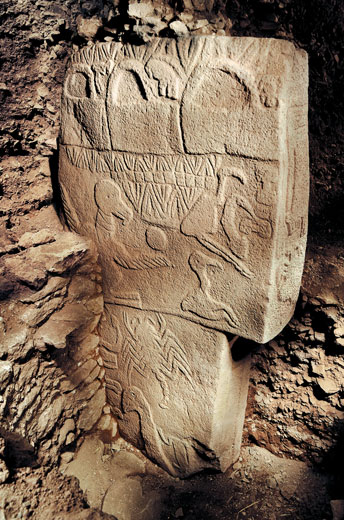 Archaeologist Klaus Schmidt downplays extravagant spiritual interpretations of Göbekli Tepe, such as the idea, made popular in the press, that the site is the inspiration for the Biblical Garden of Eden. But he does agree that it was a sanctuary of profound significance in the Neolithic world. He sees it as a key site in understanding the transition from hunting and gathering to agriculture, and from tribal to regional religion.
Archaeologist Klaus Schmidt downplays extravagant spiritual interpretations of Göbekli Tepe, such as the idea, made popular in the press, that the site is the inspiration for the Biblical Garden of Eden. But he does agree that it was a sanctuary of profound significance in the Neolithic world. He sees it as a key site in understanding the transition from hunting and gathering to agriculture, and from tribal to regional religion.
Schmidt and his colleagues estimate that at least 500 people were required to hew the 10- to 50-ton stone pillars from local quarries, move them from as far as a quarter-mile away, and erect them. How did Stone Age people achieve the level of organization necessary to do this? Hauptmann speculates that an elite class of religious leaders supervised the work and later controlled the rituals that took place at the site. If so, this would be the oldest known evidence for a priestly caste–much earlier than when social distinctions became evident at other Near Eastern sites.
Klaus Schmidt of the German Archaeological Institute believes Göbekli Tepe attracted small nomadic groups from numerous regions throughout southeastern Anatolia. (Haldun Aydingün)
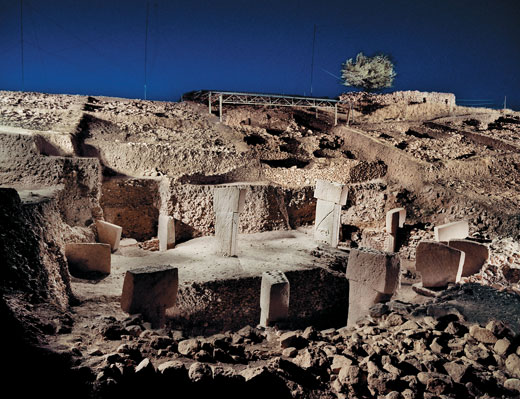 Before the discovery of Göbekli Tepe, archaeologists believed that societies in the early Neolithic were organized into small bands of hunter-gatherers and that the first complex religious practices were developed by groups that had already mastered agriculture. Scholars thought that the earliest monumental architecture was possible only after agriculture provided Neolithic people with food surpluses, freeing them from a constant focus on day-to-day survival. A site of unbelievable artistry and intricate detail, Göbekli Tepe has turned this theory on its head.
Before the discovery of Göbekli Tepe, archaeologists believed that societies in the early Neolithic were organized into small bands of hunter-gatherers and that the first complex religious practices were developed by groups that had already mastered agriculture. Scholars thought that the earliest monumental architecture was possible only after agriculture provided Neolithic people with food surpluses, freeing them from a constant focus on day-to-day survival. A site of unbelievable artistry and intricate detail, Göbekli Tepe has turned this theory on its head.
Schmidt believes the people who created these massive and enigmatic structures came from great distances. It seems certain that once pilgrims reached Göbekli Tepe, they made animal sacrifices. Schmidt and his team have found the bones of wild animals, including gazelles, red deer, boars, goats, sheep, and oxen, plus a dozen different bird species, such as vultures and ducks, scattered around the site. Most of these animals are depicted in the sculptures and reliefs at the site.
There is still much that we don’t understand about religious practices at Göbekli Tepe, Schmidt cautions. But broadly speaking, the animal images “probably illustrate stories of hunter-gatherer religion and beliefs,” he says, “though we don’t know at the moment.” The sculptors of Göbekli Tepe may have simply wanted to depict the animals they saw, or perhaps create symbolic representations of the animals to use in rituals to ensure hunting success.
Schmidt has another theory about how Göbekli Tepe became a sacred place. Though he has yet to find them, he believes that the first stone circles on the hill of the navel marked graves of important people. Hauptmann’s team discovered graves at Nevali Cori, and Schmidt is reasonably confident that burials lie somewhere in the earliest layers of Göbekli Tepe. This leads him to suspect the pillars represent human beings and that the cult practices at this site may initially have focused on some sort of ancestor worship. The T-shaped pillars, he points out, look like human bodies with the upper part of the “T” resembling a head in profile. Once, Schmidt says, they stood on the hillside “like a meeting of stone beings.”
by Sandra Scham from archaeology.org
